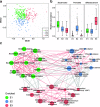Impact of early events and lifestyle on the gut microbiota and metabolic phenotypes in young school-age children
- PMID: 30609941
- PMCID: PMC6320620
- DOI: 10.1186/s40168-018-0608-z
Impact of early events and lifestyle on the gut microbiota and metabolic phenotypes in young school-age children
Abstract
Background: The gut microbiota evolves from birth and is in early life influenced by events such as birth mode, type of infant feeding, and maternal and infant antibiotics use. However, we still have a gap in our understanding of gut microbiota development in older children, and to what extent early events and pre-school lifestyle modulate the composition of the gut microbiota, and how this impinges on whole body metabolic regulation in school-age children.
Results: Taking advantage of the KOALA Birth Cohort Study, a long-term prospective birth cohort in the Netherlands with extensive collection of high-quality host metadata, we applied shotgun metagenomics sequencing and systematically investigated the gut microbiota of children at 6-9 years of age. We demonstrated an overall adult-like gut microbiota in the 281 Dutch school-age children and identified 3 enterotypes dominated by the genera Bacteroides, Prevotella, and Bifidobacterium, respectively. Importantly, we found that breastfeeding duration in early life and pre-school dietary lifestyle correlated with the composition and functional competences of the gut microbiota in the children at school age. The correlations between pre-school dietary lifestyle and metabolic phenotypes exhibited a striking enterotype dependency. Thus, an inverse correlation between high dietary fiber consumption and low plasma insulin levels was only observed in individuals with the Bacteroides and Prevotella enterotypes, but not in Bifidobacterium enterotype individuals in whom the gut microbiota displayed overall lower microbial gene richness, alpha-diversity, functional potential for complex carbohydrate fermentation, and butyrate and succinate production. High total fat consumption and elevated plasma free fatty acid levels in the Bifidobacterium enterotype are associated with the co-occurrence of Streptococcus.
Conclusions: Our work highlights the persistent effects of breastfeeding duration and pre-school dietary lifestyle in affecting the gut microbiota in school-age children and reveals distinct compositional and functional potential in children according to enterotypes. The findings underscore enterotype-specific links between the host metabolic phenotypes and dietary patterns, emphasizing the importance of microbiome-based stratification when investigating metabolic responses to diets. Future diet intervention studies are clearly warranted to examine gut microbe-diet-host relationships to promote knowledge-based recommendations in relation to improving metabolic health in children.
Keywords: Enterotype; Gut microbiota; Metabolic phenotypes; School-age children.
Conflict of interest statement
Ethics approval and consent to participate
For the KOALA Birth Cohort Study, written informed consent was given by all parents, and the study was approved by the Medical Ethics Committee of Maastricht University Medical Centre (MUMC) and the National Committee of Medical Research. The MIBS-CO study was also approved by the institutional ethics review board of the MUMC and all participants signed an informed consent form.
Competing interests
The authors declare that they have no competing interests.
Publisher’s Note
Springer Nature remains neutral with regard to jurisdictional claims in published maps and institutional affiliations.
Figures




Similar articles
-
Diversity and enterotype in gut bacterial community of adults in Taiwan.BMC Genomics. 2017 Jan 25;18(Suppl 1):932. doi: 10.1186/s12864-016-3261-6. BMC Genomics. 2017. PMID: 28198673 Free PMC article.
-
Age-based dynamic changes of phylogenetic composition and interaction networks of health pig gut microbiome feeding in a uniformed condition.BMC Vet Res. 2019 May 24;15(1):172. doi: 10.1186/s12917-019-1918-5. BMC Vet Res. 2019. PMID: 31126262 Free PMC article.
-
Driving gut microbiota enterotypes through host genetics.Microbiome. 2024 Jun 28;12(1):116. doi: 10.1186/s40168-024-01827-8. Microbiome. 2024. PMID: 38943206 Free PMC article.
-
Microbial enterotypes in personalized nutrition and obesity management.Am J Clin Nutr. 2018 Oct 1;108(4):645-651. doi: 10.1093/ajcn/nqy175. Am J Clin Nutr. 2018. PMID: 30239555 Review.
-
Bridging the Gap from Enterotypes to Personalized Dietary Recommendations: A Metabolomics Perspective on Microbiome Research.Metabolites. 2023 Dec 2;13(12):1182. doi: 10.3390/metabo13121182. Metabolites. 2023. PMID: 38132864 Free PMC article. Review.
Cited by
-
Methodological recommendations for human microbiota-gut-brain axis research.Microbiome Res Rep. 2023 Oct 17;3(1):1. doi: 10.20517/mrr.2023.33. eCollection 2024. Microbiome Res Rep. 2023. PMID: 38455088 Free PMC article. Review.
-
A systematic framework for understanding the microbiome in human health and disease: from basic principles to clinical translation.Signal Transduct Target Ther. 2024 Sep 23;9(1):237. doi: 10.1038/s41392-024-01946-6. Signal Transduct Target Ther. 2024. PMID: 39307902 Free PMC article. Review.
-
Different maturation of gut microbiome in Korean children.Front Microbiol. 2022 Nov 23;13:1036533. doi: 10.3389/fmicb.2022.1036533. eCollection 2022. Front Microbiol. 2022. PMID: 36504822 Free PMC article.
-
The Gut Microbiota and Its Implication in the Development of Atherosclerosis and Related Cardiovascular Diseases.Nutrients. 2020 Feb 26;12(3):605. doi: 10.3390/nu12030605. Nutrients. 2020. PMID: 32110880 Free PMC article. Review.
-
Effect of Different Doses of Vitamin D on the Intestinal Flora of Babies with Eczema: An Experimental Study.Life (Basel). 2022 Sep 9;12(9):1409. doi: 10.3390/life12091409. Life (Basel). 2022. PMID: 36143444 Free PMC article.
References
Publication types
MeSH terms
Substances
LinkOut - more resources
Full Text Sources
Medical
Miscellaneous

